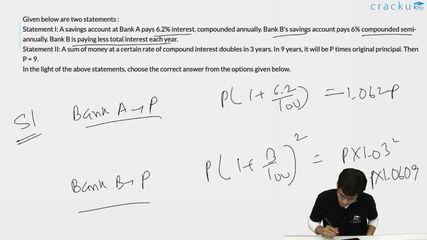Given below are two statements :
Statement I: A savings account at Bank A pays 6.2% interest, compounded annually. Bank B's savings account pays 6% compounded semi-annually. Bank B is paying less total interest each year.
Statement II: A sum of money at a certain rate of compound interest doubles in 3 years. In 9 years, it will be P times original principal. Then P = 9.
In the light of the above statements, choose the correct answer from the options given below.
Solution
Statement I:
Bank A: r = 6.2% and compounded anually
Compound interest at the end of an year = $$P\left(1+\frac{6.2}{100}\right)-P=\frac{6.2P}{100}$$
Bank B: r = 6% and compounded semi-anually
C.I = $$P\left(1+\frac{3}{100}\right)^2-P=\frac{P\left(6.09\right)}{100}$$
Interest is less in bank B.
Therefore, statement I is correct.
Statement II:
Let the sum of money be 'S'
It is given,
$$S\left(1+\frac{r}{100}\right)^3=2S$$
$$\left(1+\frac{r}{100}\right)^3=2$$
$$\left(1+\frac{r}{100}\right)^9=8$$
$$S\left(1+\frac{r}{100}\right)^9=8S$$
Therefore, P = 8
Statement II is incorrect.
The answer is option C.
Video Solution

Click on the Email ☝️ to Watch the Video Solution
Create a FREE account and get:
- All Quant Formulas and shortcuts PDF
- 40+ previous papers with detau solutions PDF
- Top 500 MBA exam Solved Questions for Free
